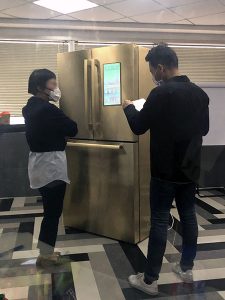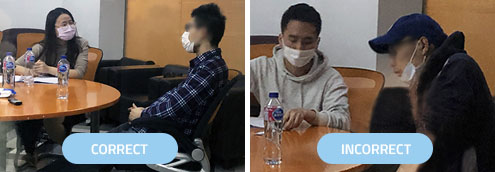The essential nature of in-person testing within certain industries, like healthcare, demands that face-to-face user research still occur. To continue to collect data safely, UX and human factors researchers must establish safety procedures that, to the extent possible, ensure the safety of the researcher, participant, and, when necessary, observers. We have been in discussions with colleagues from around the globe about various approaches, from lab modifications to check-out procedures, and have already received feedback on some challenges faced when implementing these additional procedures and advice to overcome them to continue to collect data successfully.
Tips when requiring participants and moderators to wear masks
XplusX, our China team, resumed in-person testing in early April. They have been utilizing face masks, temperature checks, and test environment sanitization, among other methods. The following are a few tips to overcome challenges they experienced:
1. Give breaks during session to catch breath. Wearing masks can put a strain on normal breathing. Because of this, our team in Shanghai found that the participant was having trouble breathing through their N95 mask. Increasing the session time by a few minutes by giving them a break, not only made the participant more comfortable but also resulted in richer responses.
2. Remind participants how to wear the mask to ensure its effectiveness. While requiring mask use can help keep all parties safe, it is only effective if worn correctly. The XplusX team discovered that some participants pulled down their masks to answer questions. This will likely have to be a reminder throughout the session, but wording can also be added to the session introduction that their mask must remain over their nose and mouth throughout the session unless otherwise noted.
 A participant was wearing an N95 mask throughout the session and, because of how much they are required to talk, got quite out of breath throughout the session and had to take breaks.
A participant was wearing an N95 mask throughout the session and, because of how much they are required to talk, got quite out of breath throughout the session and had to take breaks.

Remind participants at the start of the session how to properly wear a mask and to keep their mask on unless directed to remove it.
 A participant was wearing an N95 mask throughout the session and, because of how much they are required to talk, got quite out of breath throughout the session and had to take breaks.
A participant was wearing an N95 mask throughout the session and, because of how much they are required to talk, got quite out of breath throughout the session and had to take breaks.

Remind participants at the start of the session how to properly wear a mask and to keep their mask on unless directed to remove it.
Other safety procedures that the XplusX team implemented successfully:
![]()
Temperature checks:
This is widely accepted in China now, so there were no issues asking about participants’ current health condition or checking temperature when they arrived at the facility.
![]()
Provided snacks/water:
Pre-COVID, providing snacks and water to participants was standard. The modification to this routine was that the team only provided bottled water during the interview.
![]()
Hand-sanitizing encouraged:
Hand sanitizers and sanitizing wipes were made available and participants were informed that they can use those as they wish.
![]()
Test stimuli and environments sanitized:
Test room, reception, and test stimuli were disinfected by sanitizing spray in-between all sessions. The products/screens touched by participants were wiped with sanitizing wipes in-between each session as well.
![]()
Communication:
Participants were informed of all procedures upon reaching the facility and at the beginning of the interviews.
The key takeaway message from our team currently conducting in-person testing is that, with proper safety precautions in place, participants are comfortable throughout the session and data can be collected effectively and safely.
Are users still willing to participate in user research?
Another concern of our industry colleagues was the extent to which participants would be reluctant to show up for in-person research. Our German team at uintent recently conducted a survey, in partnership with local recruiters, to uncover the answer to this question.
“How willing are you to participate in studies with appropriate safety measures and do you consider yourself a member of an at-risk group?”
The research team was surprised and delighted that the response was overwhelmingly positive. 80% responded they are just as likely to attend sessions as they were before. And 1 in 5 put themselves into the high-risk group.
“Which safety measures are most important for your personal sense of security and willingness to participate in studies?”
The responses indicated they expected basic hygiene measures to be followed. This was also a relief that there were not unrealistic expectations for lab redesign or major overhauls of how research was conducted.
Read more about the results from uintent’s survey.
The new normal
We are all speculating what the ‘new normal’ will be for user research and the UX and human factors industry. Ultimately, in-person testing is one of our core methods, so we must find ways to collect data safely. As we continue to implement new procedures and processes to accomplish this, keeping an open line of communication within the industry will be key. Our shared goal of designing products that deliver effective, engaging, and satisfying experiences demands that we continually improve the methods we employ to inform those designs.
